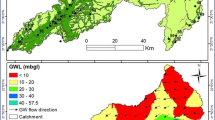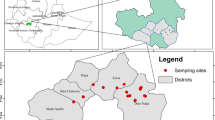Abstract
This study aimed to assess how poor planning for irrigation led to heavy salt loads, how those salt loads adversely affected the environment, and how to identify management practices to deal with these potential problems in the Great Menderes River Basin, Aydın Plain Irrigation Scheme of Turkey for the period between 2000 and 2006. In order to determine the effects on the environment; electrical conductivity, salinity load, total amount of water table salinity, inflow and outflow salinity were measured and calculated for the research area. There was no problem on account of water table fluctuations. The mean of area prevented the plant growth by high water table was 8.5%. The percentage of the area occurring water table salinity problem was 39.2. The total amount of salt transported to the Great Menderes River and accumulated in the soil of the research area was 211,609 and 246,565 tones respectively. Salt, 458,174 tones in total, had adverse effects on the environment.
Similar content being viewed by others
References
Anonymous (2003). Assessment of river salinity in the Lachlan River Catchment 2000/2001. Central West Region, NSW Department of Sustainable Natural Resources. ISBN: 0 7347 5259 8, 9 Spring Street, Forbes NSW 2871.
Anzecc & Armcanz (2000). Australian and New Zealand guidelines for fresh and marina water quality. National water quality management strategy. Canberra: Australian and New Zealand Environment and Conservation Council & Agriculture and Resource Management Council of Australia and New Zealand.
Ayers, R. S., & Westcot, D. W. (1985). Water quality for agriculture (p. 174). Irrigation and Drainage Paper 29. Rev 1. Food and Agriculture Organization of the United States. Rome.
Barrett-Lennard, E. G. (2002). Restoration of saline land though revegetation. Agricultural Water Management, 53, 213–229. doi:10.1016/S0378-3774(01)00166-4.
Boulton, A., & Brock, M. (1999). Australian freshwater ecology: Process and management (p. 195). Glen Osmond: Gleneagles Publishing.
DSI (1996). Stage I Projects Büyük Menderes River Basin Feasibility Report (p. 572). Ankara: Republic of Turkey Ministry of Energy and Natural Resources, General Directorate of State Hydraulic Works (DSI).
DSI (2000). Water table monitoring and evaluation report in schemes (p. 15). Ankara: General Directorate of State Hydraulic Works, Operation and Maintenance Department, XXI Regional Directorate (DSI).
DSI (2001). Water table monitoring and evaluation report in schemes (p. 17). Ankara: General Directorate of State Hydraulic Works (DSI), Operation and Maintenance Department, XXI Regional Directorate.
DSI (2002). Water table monitoring and evaluation report in schemes (p. 20). Ankara: General Directorate of State Hydraulic Works (DSI), Operation and Maintenance Department, XXI Regional Directorate.
DSI (2003). Water table monitoring and evaluation report in schemes (p. 18). Ankara: General Directorate of State Hydraulic Works (DSI), Operation and Maintenance Department, XXI Regional Directorate.
DSI (2004). Water table monitoring and evaluation report in schemes (p. 16). Ankara: General Directorate of State Hydraulic Works (DSI), Operation and Maintenance Department, XXI Regional Directorate.
DSI (2005). Water table monitoring and evaluation report in schemes (p. 21). Ankara: General Directorate of State Hydraulic Works (DSI), Operation and Maintenance Department, XXI Regional Directorate.
DSI (2006a). Water table monitoring and evaluation report in schemes (p. 23). Ankara: General Directorate of State Hydraulic Works, Operation and Maintenance Department, XXI Regional Directorate.
DSI (2006b). Annual evaluation report of irrigation activities in DSI-operated and transferred schemes (p. 19). Ankara: General Directorate of State Hydraulic Works (DSI), Operation and Maintenance Department.
FAO (2000). Selecting of Country Specific Salinity Issue(s). Extent and causes of salt-affected soils in participating countries. Land and Nutrition Management Service, Global Network on Integrated Soil Management for Sustainable Use of Salt-affected Soils. Last Update: 10 November 2000. http://www.fao.org/ag/AGL.
Ghassemi, F., Jakeman, A. J., & Nix, H. A. (1995). Salinization of land and water resources. Canberra, Australia: Centre for Resources and Environmental Studies.
Güneş, A., Inal, A., Alpaslan, M., & Çıkılı, Y. (1999). Effect of salinity on P induced Zn deficiency in paper plants. Tr. Journal of Agriculture and Forestry, 23, 459–464.
James, K. R., & Hart, B. T. (1993). Effects of salinity on four freshwater macrophytes. Australian Journal of Freshwater Research, 44, 769. doi:10.1071/MF9930769.
Jolly, I. D., Williamson, D. R., Gilfedder, M., Walker, G. R., Mortan, R., Robinson, G., et al. (2001). Historical stream salinity trends and catchment salt balances in the Murray-Darling Basin. Australian Journal of Marine and Freshwater Research, 52, 53–63. doi:10.1071/MF00018.
Koc, C. (2007). Effects of geothermal wastewater and boron pollution in Great Menderes Basin on environment and agriculture. Environmental Monitoring and Assessment, 125, 377–388. doi:10.1007/s10661-006-9378-3.
Koc, C., Akar, D., & Özdemir, K. (2007). Measurement and evaluation of the performance of management-operation and maintenance of irrigation schemes in before-and-after turnover: A case study at Great Menderes Basin, Turkey. Water Saving in Mediterranean Agriculture & Future Research Needs. WASAMED Project. Proceedings of Inter national Conference (p. 239). Valenzano, Italy. ISSN:1016-1228.
Marchant, R., Hirst, A., Norris, R., & Metzeling, L. (1999). Classification of macroinvertebrate communities across drainage basins in Victoria, Australia: Consequences of sampling on a board spatial scale for predictive modeling. Freshwater Biology, 41, 253–268. doi:10.1046/j.1365-2427.1999.00429.x.
McFarlane, D. J., & Williamson, D. R. (2002). An overview of water logging and salinity in southwestern Australia as related to the ‘Ucarro’ experimental catchment. Agricultural Water Management, 53 (1–3), 5. doi:10.1016/S0378-3774(01)00153-6.
MDBC (1990). A pipeline to the sea: Pre-feasibility study. Canberra, Australia: Gutteridge Haskins and Davey Engineering Firm, Australian Groundwater Consultants, Murray Darling Basin Commission (MDBC).
Metzeling, L. (1993). Benthic macroinvertebrate community structure in streams of different salinities. Australian Journal of Marine and Freshwater Research, 44, 335–346. doi:10.1071/MF9930335.
Newman, B., & Goss, K. (2000). Murray-darling basin commission (MDBC), Murray-Darling basin salinity management strategy-implications for the irrigation sector. ANCID Conference.
Nielsen, D. L., & Hillman, T. J. (2000). Ecological effects of dryland salinity on aquatic ecosystems. Albury: Cooperative Research Centre for Freshwater Research, Murray-Darling Freshwater Centre.
Pavelic, P., Dillon, P. J., Narayan, K. A., Hermann, T. N., & Barnet, S. R. (1997). Integrated groundwater flow and agronomic modeling for management of dryland salinity of a coastal plain in Southern Australia. Agricultural Water Management, 35(1–2), 75. doi:10.1016/S0378-3774(97)00027-9.
Pearce, D. W., & Warford, J. (1994). World without end, economics environment and sustainable development. USA: Oxford University Press.
Ponnamperuma, F. N., & Bandyopodhya, H. K. (1980). Soil salinity as a constraint on food production in the humid tropics. In Priorities for alleviating soil related constraints to food production in the tropics (p. 203). Los Banos.
Prathapar, S. A., Meyer, W. S., Bailey, M. A., & Poulton, D. C. (1996). A soil water and groundwater simulation model: SWAGDIM. Environmental Software, 11(3), 151. doi:10.1016/S0266-9838(96)00038-X.
Smedema, L. K. (2000). Irrigation-induced river salinizitation: Five major irrigated basins in the arid z C. one. IWMI. Colombo.
SRDCC (2002). A strategic framework for salinity research and development in NSW. Salinity Researched and Development Coordinating Committee. Orange: NSW Agriculture.
World Bank (1992). Development and environment. World Development Report 1992 (p. 57). World Bank Washington, DC.
Author information
Authors and Affiliations
Corresponding author
Rights and permissions
About this article
Cite this article
Koç, C. The environmental effects of salinity load in Great Menderes Basin irrigation schemes. Environ Monit Assess 146, 479–489 (2008). https://doi.org/10.1007/s10661-008-0478-0
Received:
Accepted:
Published:
Issue Date:
DOI: https://doi.org/10.1007/s10661-008-0478-0




